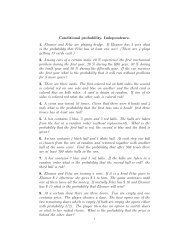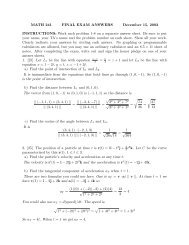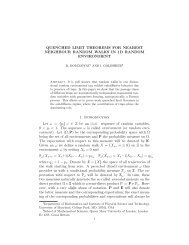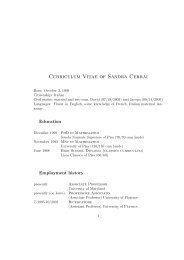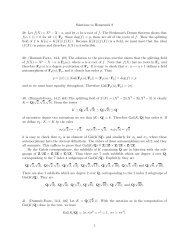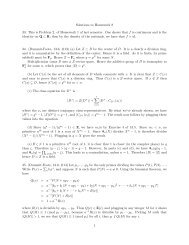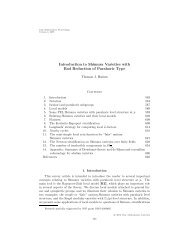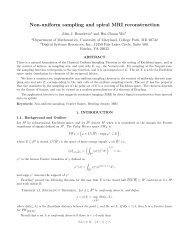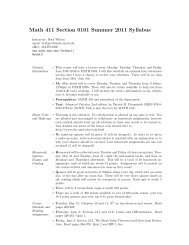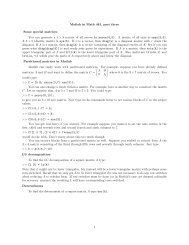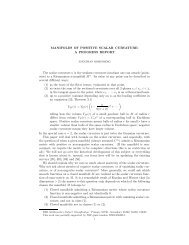Solutions to Homework 7 35. (Dummit-Foote 8.2 #6) (a) Let S be the ...
Solutions to Homework 7 35. (Dummit-Foote 8.2 #6) (a) Let S be the ...
Solutions to Homework 7 35. (Dummit-Foote 8.2 #6) (a) Let S be the ...
- No tags were found...
You also want an ePaper? Increase the reach of your titles
YUMPU automatically turns print PDFs into web optimized ePapers that Google loves.
<strong>Solutions</strong> <strong>to</strong> <strong>Homework</strong> 7<strong>35.</strong> (<strong>Dummit</strong>-<strong>Foote</strong> <strong>8.2</strong> <strong>#6</strong>) (a) <strong>Let</strong> S <strong>be</strong> <strong>the</strong> set of all ideals of R that are not principal, and let{C α } α∈I <strong>be</strong> a chain in S. The chain C α has as upper bound ⋃ α∈I C α. This union is clearly an ideal.To see that it is non-principal, note that any genera<strong>to</strong>r d would have <strong>to</strong> live in C α for some α,implying C α = (d), a contradiction. As every chain in S has an upper bound, a maximal elemen<strong>to</strong>f S exists by Zorn’s Lemma.(b) <strong>Let</strong> I <strong>be</strong> a maximal element of <strong>the</strong> set S defined in part (a). By hypo<strong>the</strong>sis, I is not prime,hence we can find a, b ∈ R such that ab ∈ I but nei<strong>the</strong>r a nor b is in I. As I I a , we must haveI a = (α) for some α ∈ R, by maximality of I.As bI a ⊆ I, we have b ∈ J, and it follows from <strong>the</strong> definition of ideal that I ⊆ J. It is now clearthat I I b ⊆ J. Again by maximality of I, J is principal, say J = (β). The product of principalideals is principal, so I a J = (αβ). But by <strong>the</strong> definition of J, we have I a J ⊆ I.(c) <strong>Let</strong> x ∈ I ⊆ I a = (α). Then x = sα for some s ∈ R, and it is easy <strong>to</strong> see from <strong>the</strong> definitionof J that s ∈ J. Thus x ∈ I a J, but x was arbitrary, so it follows that I ⊆ I a J = (αβ). By part(b), we now know that I = (αβ), which contradicts <strong>the</strong> fact that I is non-principal. Therefore Smust <strong>be</strong> empty, i.e. R is a PID.36. (<strong>Dummit</strong>-<strong>Foote</strong> <strong>8.2</strong> #8) <strong>Let</strong> I <strong>be</strong> an ideal in D −1 R. <strong>Let</strong>I ′ = {r ∈ R | <strong>the</strong>re exists d ∈ D such that r/d ∈ I }.It is straightforward <strong>to</strong> verify that I ′ is an ideal of R. As R is a PID, we must have I = (α) forsome α ∈ R. Then <strong>the</strong> same α will generate D −1 I ′ = I in D −1 R.37. (<strong>Dummit</strong>-<strong>Foote</strong> 8.3 <strong>#6</strong>) (a) The ring Z[i] is a PID, hence prime ideals are maximal. As 1 + i isirreducible by Proposition 18, <strong>the</strong> ideal (1+i) is prime and hence Z[i]/(1+i) is a field. To count itscardinality note that 2 = (1 + i)(1 − i) and 2i = (1 + i) 2 , and that i = i + 1 − 1. Thus in Z[i]/(1 + i),we have ¯2 = 0 = ¯2i, and ī = ¯1. From this it is easy <strong>to</strong> see that {0, 1} make up a complete list ofcoset representatives, hence Z[i]/(1 + i) has order 2.(b) By hypo<strong>the</strong>sis, (q) is prime and thus Z[i]/(q) is a field by <strong>the</strong> same reasoning as in part (a).To count its order, note that <strong>the</strong> same{a + bi |0 ≤ a ≤ q − 1, 0 ≤ b ≤ q − 1 }is a complete list of coset representatives, and has order q 2 .(c) <strong>Let</strong> p = π¯π in Z[i]. Now π and ¯π are distinct irreducibles, and <strong>the</strong>ir gcd (Z[i] is a Euclideandomain) is equal <strong>to</strong> 1. Thus <strong>the</strong> ideals <strong>the</strong>y generate are coprime, henceZ[i]/(p) ∼ = Z[i]/(π) × Z[i]/(¯π)by <strong>the</strong> Chinese Remainder <strong>the</strong>orem. By <strong>the</strong> same reasoning as in part (b), <strong>the</strong> ring Z[i]/(p) hasorder p 2 . The only non-trivial fac<strong>to</strong>rization of p 2 is p · p, hence both fac<strong>to</strong>rs on <strong>the</strong> left-hand side1
of <strong>the</strong> above equation have order p.38. (<strong>Dummit</strong>-<strong>Foote</strong> 9.2 #4) Suppose p 1 , . . . , p n were a complete list of primes in F [x]. <strong>Let</strong>q = p 1 · · · p n + 1. Then p i ∤ q for all i, which implies that q is a unit <strong>be</strong>cause F [x] is a UFD.But deg(q) > 0, a contradiction.39. Clearly if a ∈ R × <strong>the</strong>n I = (a, X) = (1), so I is principal.For <strong>the</strong> converse, assume I = (p) is principal. Then a is a multiple of p, which implies thatdeg(p) = 0. Now X is also a multiple of p, so <strong>the</strong>re exists some b + cX ∈ R[X] such thatp(b + cX) = pb + pcX = X.Equating <strong>the</strong> coefficients of X, we see that pc = 1, i.e. that p is a unit in R. So (a, X) = (1), whichsays that <strong>the</strong>re exist s, t ∈ R[X] such thatsa + tX = 1.Equating coefficients again immediately yields sa = 1, and hence a is a unit in R.2




